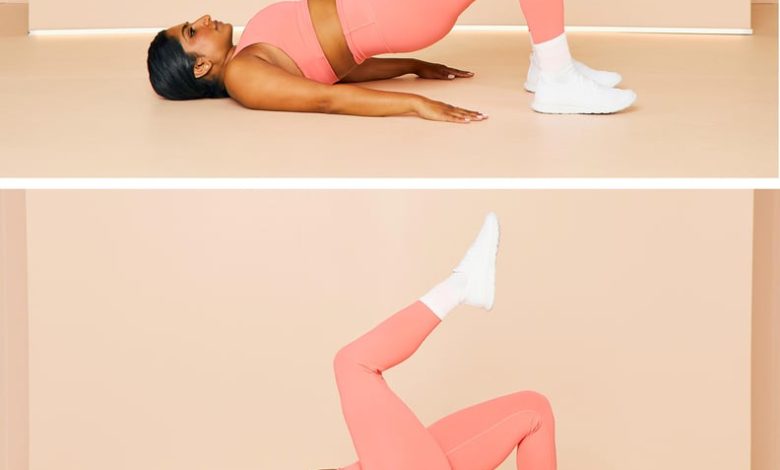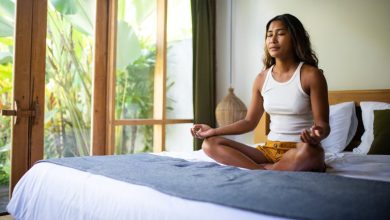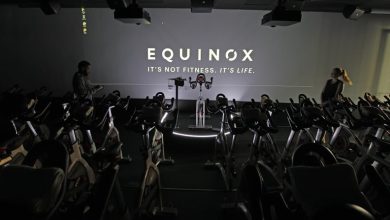7 Glute-Activation Exercises That Belong in Every Fitness Routine

Activating your glutes is one of those workout terms that’s often said, but rarely explained (similar to engaging your core!). But glute activation, or firing up your glute muscles, is super important — and for more than just strength training workouts. When your glutes aren’t working properly and engaged, the rest of your body suffers the consequences, resulting in potential pain or injury.
Take for example how often we’re seated in our daily lives. Extended periods of sitting can cause hip flexor muscles to tighten and even “turn off” your glutes entirely, leaving you with a very real case of dead butt syndrome, per the Cleveland Clinic.
Especially during COVID, our time sitting down increased, and continues to be a major part of our work day, whether we’re WFH or in office. “[We’re] sitting for work, sitting in cars, sitting once we get home. Because of this, dead butt syndrome has become its own epidemic,” says Ife Obi, ACE-certified personal trainer and certified Pilates trainer. This typically manifests as muscle tightness and numbness in the glutes, but can gradually escalate to more severe pain and inflammation.
Glute-activation exercises are the answer for protecting your entire body — not just your butt — from unnecessary discomfort. “Whether in a workout or walking up stairs, if our glutes aren’t kicking in, then it will throw our alignment out of whack leading to key issues like back and knee pain,” says Obi. She emphasizes that many people don’t even realize how much we use our glutes throughout the day, relying on them to keep us upright, stable, and moving forward.
Strengthening your glute muscles is crucial in ensuring that they’re ready when you need them, whether that’s during a workout or squatting down to pick up your kid. Ahead, we’ve rounded up seven of the best glute-activation exercises, all of which can be done without any equipment. For the record, you don’t need to do them all together — choose three moves from the list ahead, and complete two to three sets of 10 to 12 reps for each exercise. For energizing sleepy glutes, protecting against injury, and building a stronger butt, aim to do these glute-activation exercises about three times a week.
— Additional reporting by Lauren Mazzo, Chandler Plante, and Jade Esmeralda
Expert Featured in This Article
Ife Obi is an ACE-certified personal trainer and certified Pilates trainer.
The glute bridge is a classic bodyweight exercise you’ll find in tons of workout styles, from Pilates to yoga and functional fitness. To use this as a glute-activation exercise, you don’t need any equipment, but if you want to take this one up a notch, you can also try weighted glute bridges.
- Lie on your back with your knees bent and feet flat on the floor. Plant your palms by your sides, face down.
- Engage your core, and raise your hips up to the ceiling, squeezing your butt as you do. You should be making a diagonal line with your body from shoulders to knees.
- Hold for one second, then lower to the ground. Throughout the movement, try not to arch or round your back.
- That’s one rep.
One of the most important jobs your glutes do is leg abduction (i.e., moving your legs out to the sides). This glute-activation exercise ensures you prime your butt muscles for that action, which comes in handy if you’re doing an activity with side-to-side movements, like tennis or pickleball.
- Start on all fours with your hands directly under your shoulders and your knees directly under your hips. Lift your right knee and foot to just hover off the floor with your foot flexed. This is your starting position.
- Keeping your right knee bent at a 90-degree angle, slowly raise your leg out to the side until it is parallel to the ground, or as high as is comfortable. Avoid tilting your hips to the side.
- With control, lower your right leg to the starting position.
- That’s one rep.
Another important movement your glutes do? Pull your legs backward. You can accomplish this movement — and thus activate your glutes — by doing a move like a donkey kick (shown here) or kickback (shown below).
- Start on all fours, with your hands directly under your shoulders and your knees directly under your hips. Lift your right knee and foot to just hover off the floor with your foot flexed. This is your starting position.
- Keeping your right knee bent at a 90-degree angle, slowly raise your leg out behind you until your thigh is almost parallel to the floor, or as high as is comfortable. (Think about stamping your foot on the ceiling.)
- Hold for one second, then slowly lower your right knee to return to the starting position. Try not to arch or round your back throughout the movement.
- That’s one rep.
If you don’t have a small-loop resistance band (aka a miniband), you can do this glute-activation exercise with just your bodyweight. Either way, don’t step your feet completely together as you walk; keep them slightly apart so your glute muscles remain engaged.
- Place a resistance band just above or below your knees (the lower it is, the harder it will be). Begin standing with your feet directly underneath your hips, and squat about halfway down.
- Engage your core, and take a large step sideways to the right.
- Actively resist the pull of the exercise band as you bring your left leg slowly toward your right, returning to the starting position.
- That’s one rep. (Be sure to do an equal number of reps in both directions.)
If you’re a beginner to glute-activation exercises, this one might be difficult, and that’s OK. To modify, instead of lifting your foot all the way up, just lift onto your toes; the majority of the work should still be happening in the other leg.
- Lie on your back with your knees bent, feet flat on the floor, and hands by your sides. Engage your core, and raise your hips up to the ceiling so your body forms a straight diagonal from shoulders to knees.
- Lift the left leg off the floor and straighten your knee so that your thighs are parallel and all the weight is in your right foot. This is your starting position.
- Lower your hips with control to tap the floor, then press your right heel into the floor to lift your pelvis up and return to the starting position. Try not to tilt your hips or arch your back; if your form starts to deteriorate, modify by placing your other foot back on the floor.
- That’s one rep.
=The marching glute bridge is a great way to prepare your glute muscles for the more advanced single-leg glute bridge and also fire up your core and hip flexors. Take this one nice and slow; don’t try to rush through the reps.
- Lie on your back with your knees bent, feet flat on the floor, and hands by your sides. Engage your core, and raise your hips up to the ceiling so your body forms a straight diagonal from shoulders to knees.
- Lift your right leg off the floor, keeping it bent at a 90-degree angle, pausing when your shin is parallel to the floor.
- Slowly lower your right foot to the floor, then repeat on the opposite side. Try not to tilt or drop your hips or arch your back.
- That’s one rep.
This glute-activation exercise will both wake up the glute of the kicking leg, as well as encourage some balance work in the standing leg — a win-win for your workout warmup, no matter what your sweat session includes. If you need to, you can use a chair or wall for balance for these booty kicks.
- Stand tall with your feet hip-width apart, hands clasped in front of your chest or on your hips. Lift your right foot to hover just off the floor, keeping your foot flexed and putting all your weight in your left leg. This is your starting position.
- Keeping your left leg straight but not locked, lift your right leg directly behind you. Keep your right foot flexed, and squeeze your glutes to lift your heel as high as you can without leaning your torso forward or arching your back.
- Lower your right leg to return to the starting position.
- That’s one rep.
Tamara Pridgett was an associate editor with PS Fitness. She’s a NASM-certified personal trainer and Precision Nutrition level 1 coach, and was a Division 1 All-American sprinter.
Lauren Mazzo was the senior fitness editor at PS. She is a certified personal trainer and fitness nutrition specialist through the American Council on Exercise. Prior to joining PS, she worked for six years as a writer and editor for Shape Magazine covering health, fitness, nutrition, mental health, sex and relationships, beauty, and astrology.
Chandler Plante is an assistant editor for PS Health & Fitness. Previously, she worked as an editorial assistant for People magazine and contributed to Ladygunn, Millie, and Bustle Digital Group. In her free time, she overshares on the internet, creating content about chronic illness, beauty, and disability.
Jade Esmeralda, MS, CSCS, is a Staff Writer, Health & Fitness. A life-long martial artist and dancer, Jade has a strong passion for strength & conditioning, sports science, and human performance. She graduated with a Master of Science degree in Exercise Science and Strength and Conditioning from George Washington University.




